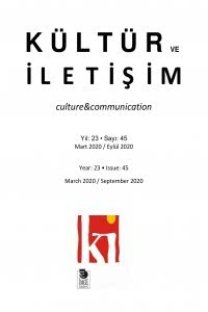Gündelik Hayatın Tarihine Dokunma Çabası: Mikro Tarihçilik ve Carlo Ginzburg
20. yüzyılın ikinci yarısında, niceliksel yöntemleri kullanarak genelleştirici sonuçlara ulaşan büyük anlatılara karşı, sıradan insanların gündelik hayatına odaklanmayı amaçlayan yeni bir tarih yazıcılığı gelişmiştir. Bu yeni tarih yazımı geleneğinin temsilcilerinden biri de mikro tarihçilik olmuştur. Makro tarihin görmezden geldiği sıradan insanları tarih yazımının merkezine oturtmaya çalışan mikro tarihçiliğin en önemli temsilcilerinden biri de Carlo Ginzburg’dur. Bu makalede mikro tarihçilik anlayışı hem onu doğuran sosyal ve düşünsel ortam üzerinden hem de en önemli temsilcilerinden biri olan Carlo Ginzburg’un Peynir ve Kurtlar isimli çalışması üzerinden analiz edilmeye çalışılmıştır. Makalede aynı zamanda Ginzburg’un tarih yazıcılığı üzerinden kültür tarihçiliğinin temel sorunlarından biri olan kurgu ile gerçek arasındaki ilişkiye de değinilmeye çalışılmıştır.
Anahtar Kelimeler:
Tarih yazımı, kültür tarihi, mikro tarihçilik, Carlo Ginzburg
The Attempt to Deal With the History of Daily Life: Micro History and Carlo Ginzburg
The second half of the twentieth century witnessed the rise of a new historiography which criticized the quantitative generalized methods of the grand narratives and aimed to stress on the daily life of the ordinary people. Micro-history is one of the constituent of such a historiography. It focused on the ordinary people whom are neglected by macro analysis. The one of the most important representatives of the micro history is Carlo Ginzburg. In this article, the social and intellectual context which led to the rise of micro history was described and the basic principles of the micro history was examined through the one of the best example of this tradition, Carlo Ginzburg’s The Cheese and Worms. Moreover, this article dealt with the basic problems of cultural history such as the relation between the fiction and reality within the context of the historiography of Ginzburg.
Keywords:
Historiography, Cultural History, Micro History, Carlo Ginzburg,
___
- Ali, Tarık (1998). Introduction in 1968: Marching the Streets. Tarık Ali ve S. Watkings (der.) London: Bloomsbury.
- Burke, Peter (2005). Tarih ve Toplumsal Kuram. Çev., Mete Tuncay. İstanbul: Tarih Vakfı Yurt Yayınları.
- Burke, Peter (2004). What is Cultural History. Cambridge: Polity.
- Chakrabarty, Dipesh (2002). “A Small History of Subaltern Studies.” Habitations of Modernity: Essays in the Wake of Subaltern Studies içinde. Chicago: University of Chicago. 3-19.
- Clark, Elisabeth Ann (2004). History, Theory, Text. Cambridge: Harvard University.
- Eley, Geoff (1996). “Is All the World a Text? From Social History to the History of Society Two Decades Later.” The Historic Turn in the Human Sciences, Terrence. J. Mc Donald (der.) içinde. Ann Arbor: Michigan State University. 193-245.
- Eley, Geoff ve Nield, Keith (1997). “Starting Over: the Present, the Post- Modern and the Moment of Social History” The Postmodern History Reader, Keith Jenkins (der.) içinde. London: Routledge. 366-380.
- Geertz, Clifford. (1973) “Thick Description: Toward an Interpretive Theory of Culture.” The Interpretations of Cultures içinde. New York: Basic Books. 3-30.
- Ginzburg, Carlo (1991). “Checking the Evidence: The Judge and the Historian.” Critical Inquiry 18(1): 79-92.
- Ginzburg, Carlo (2005). “Conversation with Orion”. Çev., Giovanni Zanalda. Perspectives 43 (5). http://www.historians.org/perspectives/ issues/2005/0505/0505/arc1.cfm.html. Erişim Tarihi: 02.04.2012.
- Ginzburg, Carlo (1999b). History, Rhetoric and Proof. Hanover: University Press of New England.
- Ginzburg, Carlo (1993). “Microhistory Two or Three Things That I Know about It.” Çev., John ve Anne C. Tedeshi, Critical Inquiry 20 (1): 10-35.
- Ginzburg, Carlo (2003). “On the Dark Side of History: Carlo Ginzburg talks to Trygve Riiser Gundersen.” Çev., J. Basil Comlishaw. http://www. eurozine.com/articles/2003-07-11-ginzburg-en.html Erişim Tarihi:07.11.2003
- Ginzburg, Carlo (1999). Peynir ve Kurtlar. Çev., Ayşen Gür. İstanbul: Metis.
- Ginzburg, Carlo (1992). The Night Battles. Çev., John ve Anne Tedeschi. Baltimore: Johns Hopkins University.
- Guha, Ranajit (1988). “On some Aspect of the Historiography of Colonial India.” Selected Subaltern Studies, Ranajit Guha ve G. C. Spivak (der.) içinde. Oxford: Oxford University Press. 1-9.
- Iggers, George (2000). Bilimsel Nesnellikten Post Modernizme Yirminci Yüzyılda Tarih Yazımı. Çev., Gül Çağalı Güven, İstanbul: Tarih Vakfı Yurt Yayınları.
- Iggers, George G (1984). New Directions in European Historiography. Middletown: Wesleyan University Press.
- Hobsbawm, Eric (1999b). “Anlatının Canlanması Üzerine”, Tarih Üzerine içinde. Çev., Osman Akınhay. Ankara: Bilim ve Sanat Yayınları.
- Hobsbawm, Eric (1999). “Aşağıdan Tarih”, Tarih Üzerine içinde. Çev., Osman Akınhay, Ankara: Bilim ve Sanat.
- Hobsbawm, Eric ( ? ). Kısa Yirminci Yüzyıl Tarihi 1914-1991: Aşırılıklar Çağı. Çev., Yavuz Alogan. İstanbul: Sarmal.
- Joyce, Patrick. (1997) “The End of Social History.” The Postmodern History Reader, Ketih Jenkins (der.) içinde. London: Routledge. 341-366.
- Kaye, Harvey J. (1995). The British Marxist Historians, New York: St Martin’s Press.
- Levi, Giovanni (1991). “On Microhistory”, New Perspectives on Historical Writing, Peter Burke (der.) içinde. Penna: University Park. 93-113.
- Marcuse, Herbert (1968). Tek Boyutlu Insan, Çev., Seçkin Çağan. Istanbul: May.
- Meddick, Hans. (1995) “ ‘Missioners in the Rawboat’ Ethnological Ways of Knowing as a Challenge to Social History”, The History of Everyday Life, Alf Lütdke (der.) içinde. Çev., William Templer. New Jersey: Princeton. 41-71.
- Revel, Jacques (2000). Microanalysis and the Construction of the Social. Çev., Arthur Goldhammer, http://www.celat.ulaval.ca/histoire.memoire/ histoire/cape2/revel.html.
- Schutte, Anne Jacobson. (1976). “Carlo Ginzburg”, The Journal of Modern History 48(2): 296-315.
- Stone, Lawrence (1979). “The Revival of Narrative: Reflections on a New Old History”, Past and Present 85:3-24.
- Thompson, Edward P. (1968). The Making of the English Working Class, Harmondsworth: Penguin Books.
- Zambelli, P. (1985). “From Menocchio to Piero Della Francesca: The Work of Carlo Ginzburg”, The Historical Journal 28(4): 983-999.
- ISSN: 1301-7241
- Yayın Aralığı: Yılda 2 Sayı
- Başlangıç: 1998
- Yayıncı: İmge Kitabevi Yayınları
